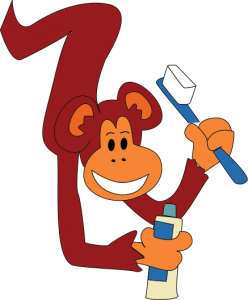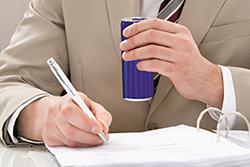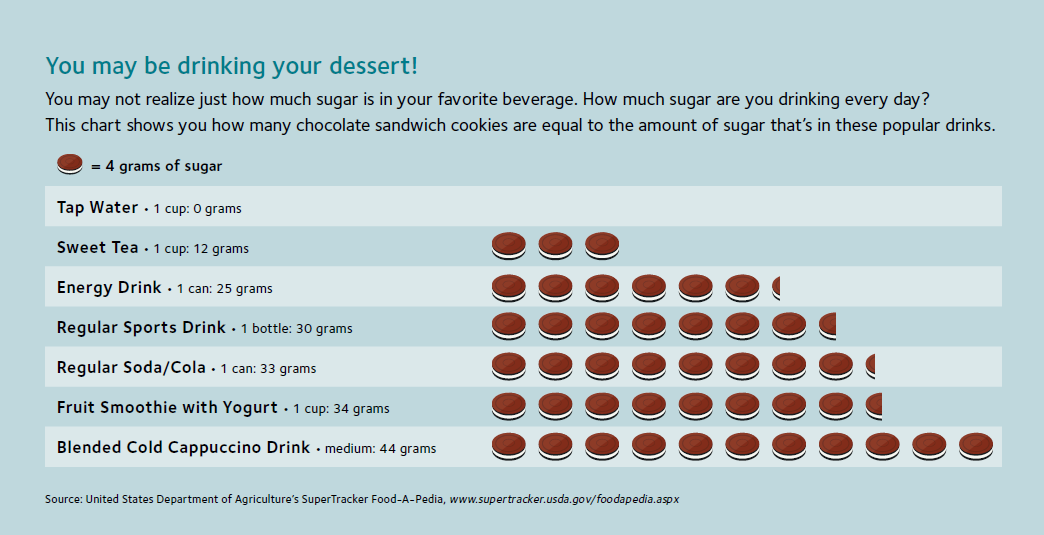9 Ways to Make Brushing Fun!
You can start using a finger toothbrush or a baby toothbrush to brush your baby’s teeth.
It takes many years before children develop the fine motor coordination they need to do a good tooth brushing job. One dentist advises that parents brush their children’s teeth until the child can neatly write his or her own name. Other dentists suggest parents use their own judgment, but think about ages six, seven, or eight, as a time for kids to take on the job of keeping their teeth clean and healthy.
While brushing is usually a fun experience, your child may go through a cranky phase when he or she hates to brush. if this happens, try not to make tooth brushing a battleground. Be casual and lighthearted about it all, brushing your own teeth with great gusto and delight, so your child sees how much fun he or she is missing.
Remember that bedtime brushing is most important and, during the day, offer your
child lots of plain water after meals.
Here are some ways to make brushing fun and easy for parents and kids:
- Brush with your child — Stand next to your child in front of the bathroom mirror and brush together. It’s a nice time together, and your child can mimic your brushing technique.
- Cute toothbrushes — There are lots of great-looking children’s brushes available in stores. Be sure to choose a toothbrush that’s small enough for your child to hold comfortably, with a small, rounded head and very soft, polished bristles. You’ll probably have to replace toothbrushes every three to four months (more often for preschoolers who tend to chew while they brush!). For babies, a soft finger toothbrush is easy for you to use. Always replace your toothbrush after a cold.
- Tasty toothpaste — For children under 4, choose a product formulated especially for children, like Baby Orajel Tooth and Gum Cleanser. It has a special mild flavor that babies and toddlers love, in Fruit or Apple-Banana. It’s also safe to swallow and non-abrasive. So tooth and gum care is easier and more fun.
- Count as you brush — Count out loud as you brush each tooth: “Tooth number one is all clean! Tooth number two is all clean! Here comes tooth number three!” This is entertaining for your child, and a good way to practice counting.
- Say Ahhhhh! — You can’t say “ahhh” with your mouth closed. As you brush his or her teeth, encourage your child to say “ahhh,” varying the pitch, tone, and rhythm to keep things interesting.
- Bring a friend — At bedtime, kids may want to invite a favorite stuffed animal into the bathroom to watch as they brush.
- Tell a toothy story — Kids love to hear favorite stories again and again. Try making up a special short story that you tell only during teeth-brushing time. It can be simple and silly, like this one: “Once there was a little girl (or boy) who had very, very dirty teeth! Oh no! said the little girl. What should I do? Boo hoo! Boo hoo! (At this point, your child can supply the sound effects.) Then all at once, a magic fairy appeared and said, I have a special treat for you! It’s a magic toothbrush! Hooray! said the little girl (boy). The magic toothbrush jumped up and brushed the dirty teeth just like this (you brush teeth), until they were as shiny as the stars in the sky. This made the little girl (boy) smile the biggest smile in the whole wide world — just like this smile right now. (Your child smiles a big smile at the mirror.) The end.”
- Make a sticker poster — Hang a piece of bright construction paper on the bathroom wall. Each time your child has a thorough brushing, he or she can choose a sticker or star and put it on the poster. You can also have your child color in Thomas, Percy, James and Gordon on our Thomas & Friends “Brushing Chart”
- Sing a toothy song — Make up a silly song to sing every time you brush. It doesn’t have to be a masterpiece. Try something like this, sung to the tune of “Old MacDonald Had a Farm:”
“Now we’re gonna brush your teeth! E-i-e-i-oh! And then they’re gonna be all clean. E-i-e-i-oh! With a brush, brush here and a brush, brush there, Here a brush, there a brush, everywhere a brush, brush, Now your teeth are nice and clean! E-i-e-i-oh!”
“Now we’re gonna brush your teeth! E-i-e-i-oh! And then they’re gonna be all clean. E-i-e-i-oh! With a brush, brush here and a brush, brush there, Here a brush, there a brush, everywhere a brush, brush, Now your teeth are nice and clean! E-i-e-i-oh!”
“Now we’re gonna brush your teeth! E-i-e-i-oh! And then they’re gonna be all clean. E-i-e-i-oh! With a brush, brush here and a brush, brush there, Here a brush, there a brush, everywhere a brush, brush, Now your teeth are nice and clean! E-i-e-i-oh!”
“Now we’re gonna brush your teeth! E-i-e-i-oh! And then they’re gonna be all clean. E-i-e-i-oh! With a brush, brush here and a brush, brush there, Here a brush, there a brush, everywhere a brush, brush, Now your teeth are nice and clean! E-i-e-i-oh!”
“Now we’re gonna brush your teeth! E-i-e-i-oh! And then they’re gonna be all clean. E-i-e-i-oh! With a brush, brush here and a brush, brush there, Here a brush, there a brush, everywhere a brush, brush, Now your teeth are nice and clean! E-i-e-i-oh!”




 Citing its relationship with dental decay, among other health-related concerns, the American Academy of Pediatrics in May released a policy statement recommending no fruit juice for children under 1 year.
Citing its relationship with dental decay, among other health-related concerns, the American Academy of Pediatrics in May released a policy statement recommending no fruit juice for children under 1 year.

